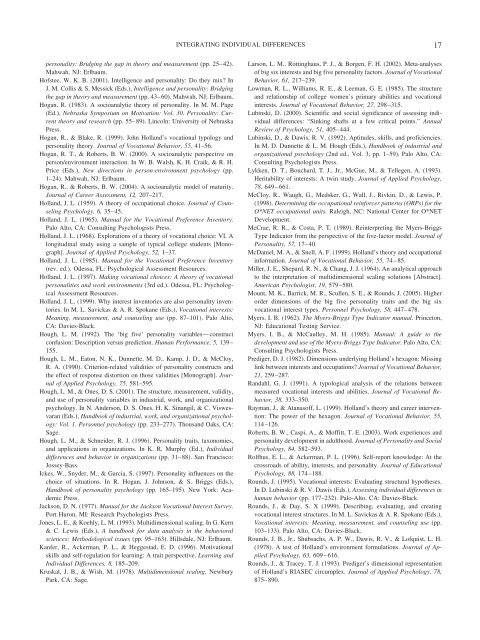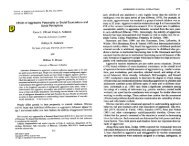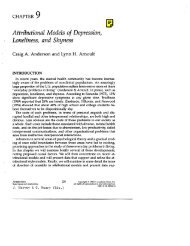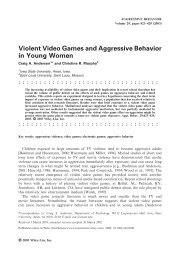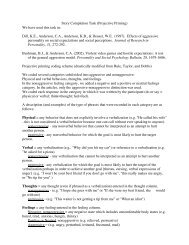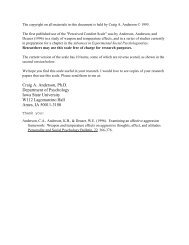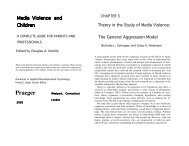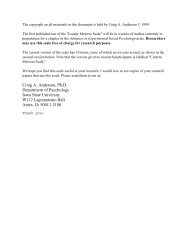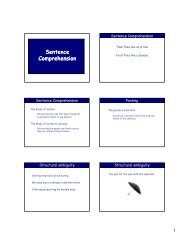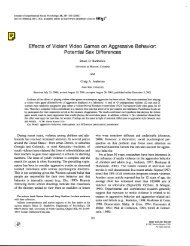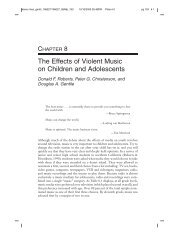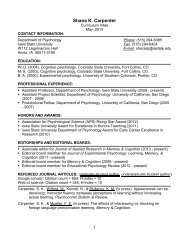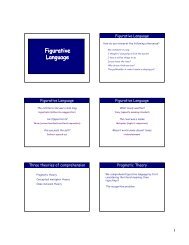Holland's RIASEC Model as an Integrative Framework for Individual ...
Holland's RIASEC Model as an Integrative Framework for Individual ...
Holland's RIASEC Model as an Integrative Framework for Individual ...
Create successful ePaper yourself
Turn your PDF publications into a flip-book with our unique Google optimized e-Paper software.
INTEGRATING INDIVIDUAL DIFFERENCES<br />
17<br />
personality: Bridging the gap in theory <strong>an</strong>d me<strong>as</strong>urement (pp. 25–42).<br />
Mahwah, NJ: Erlbaum.<br />
Hofstee, W. K. B. (2001). Intelligence <strong>an</strong>d personality: Do they mix? In<br />
J. M. Collis & S. Messick (Eds.), Intelligence <strong>an</strong>d personality: Bridging<br />
the gap in theory <strong>an</strong>d me<strong>as</strong>urement (pp. 43–60). Mahwah, NJ: Erlbaum.<br />
Hog<strong>an</strong>, R. (1983). A socio<strong>an</strong>alytic theory of personality. In M. M. Page<br />
(Ed.), Nebr<strong>as</strong>ka Symposium on Motivation: Vol. 30. Personality: Current<br />
theory <strong>an</strong>d research (pp. 55–89). Lincoln: University of Nebr<strong>as</strong>ka<br />
Press.<br />
Hog<strong>an</strong>, R., & Blake, R. (1999). John Holl<strong>an</strong>d’s vocational typology <strong>an</strong>d<br />
personality theory. Journal of Vocational Behavior, 55, 41–56.<br />
Hog<strong>an</strong>, R. T., & Roberts, B. W. (2000). A socio<strong>an</strong>alytic perspective on<br />
person/environment interaction. In W. B. Walsh, K. H. Craik, & R. H.<br />
Price (Eds.), New directions in person-environment psychology (pp.<br />
1–24). Mahwah, NJ: Erlbaum.<br />
Hog<strong>an</strong>, R., & Roberts, B. W. (2004). A socio<strong>an</strong>alytic model of maturity.<br />
Journal of Career Assessment, 12, 207–217.<br />
Holl<strong>an</strong>d, J. L. (1959). A theory of occupational choice. Journal of Counseling<br />
Psychology, 6, 35–45.<br />
Holl<strong>an</strong>d, J. L. (1965). M<strong>an</strong>ual <strong>for</strong> the Vocational Preference Inventory.<br />
Palo Alto, CA: Consulting Psychologists Press.<br />
Holl<strong>an</strong>d, J. L. (1968). Explorations of a theory of vocational choice: VI. A<br />
longitudinal study using a sample of typical college students [Monograph].<br />
Journal of Applied Psychology, 52, 1–37.<br />
Holl<strong>an</strong>d, J. L. (1985). M<strong>an</strong>ual <strong>for</strong> the Vocational Preference Inventory<br />
(rev. ed.). Odessa, FL: Psychological Assessment Resources.<br />
Holl<strong>an</strong>d, J. L. (1997). Making vocational choices: A theory of vocational<br />
personalities <strong>an</strong>d work environments (3rd ed.). Odessa, FL: Psychological<br />
Assessment Resources.<br />
Holl<strong>an</strong>d, J. L. (1999). Why interest inventories are also personality inventories.<br />
In M. L. Savick<strong>as</strong> & A. R. Spok<strong>an</strong>e (Eds.), Vocational interests:<br />
Me<strong>an</strong>ing, me<strong>as</strong>urement, <strong>an</strong>d counseling use (pp. 87–101). Palo Alto,<br />
CA: Davies-Black.<br />
Hough, L. M. (1992). The ‘big five’ personality variables—construct<br />
confusion: Description versus prediction. Hum<strong>an</strong> Per<strong>for</strong>m<strong>an</strong>ce, 5, 139–<br />
155.<br />
Hough, L. M., Eaton, N. K., Dunnette, M. D., Kamp, J. D., & McCloy,<br />
R. A. (1990). Criterion-related validities of personality constructs <strong>an</strong>d<br />
the effect of response distortion on those validities [Monograph]. Journal<br />
of Applied Psychology, 75, 581–595.<br />
Hough, L. M., & Ones, D. S. (2001). The structure, me<strong>as</strong>urement, validity,<br />
<strong>an</strong>d use of personality variables in industrial, work, <strong>an</strong>d org<strong>an</strong>izational<br />
psychology. In N. Anderson, D. S. Ones, H. K. Sin<strong>an</strong>gil, & C. Viswesvar<strong>an</strong><br />
(Eds.), H<strong>an</strong>dbook of industrial, work, <strong>an</strong>d org<strong>an</strong>izational psychology:<br />
Vol. 1. Personnel psychology (pp. 233–277). Thous<strong>an</strong>d Oaks, CA:<br />
Sage.<br />
Hough, L. M., & Schneider, R. J. (1996). Personality traits, taxonomies,<br />
<strong>an</strong>d applications in org<strong>an</strong>izations. In K. R. Murphy (Ed.), <strong>Individual</strong><br />
differences <strong>an</strong>d behavior in org<strong>an</strong>izations (pp. 31–88). S<strong>an</strong> Fr<strong>an</strong>cisco:<br />
Jossey-B<strong>as</strong>s.<br />
Ickes, W., Snyder, M., & Garcia, S. (1997). Personality influences on the<br />
choice of situations. In R. Hog<strong>an</strong>, J. Johnson, & S. Briggs (Eds.),<br />
H<strong>an</strong>dbook of personality psychology (pp. 165–195). New York: Academic<br />
Press.<br />
Jackson, D. N. (1977). M<strong>an</strong>ual <strong>for</strong> the Jackson Vocational Interest Survey.<br />
Port Huron, MI: Research Psychologists Press.<br />
Jones, L. E., & Koehly, L. M. (1993). Multidimensional scaling. In G. Kern<br />
& C. Lewis (Eds.), A h<strong>an</strong>dbook <strong>for</strong> data <strong>an</strong>alysis in the behavioral<br />
sciences: Methodological issues (pp. 95–163). Hillsdale, NJ: Erlbaum.<br />
K<strong>an</strong>fer, R., Ackerm<strong>an</strong>, P. L., & Heggestad, E. D. (1996). Motivational<br />
skills <strong>an</strong>d self-regulation <strong>for</strong> learning: A trait perspective. Learning <strong>an</strong>d<br />
<strong>Individual</strong> Differences, 8, 185–209.<br />
Kruskal, J. B., & Wish, M. (1978). Multidimensional scaling. Newbury<br />
Park, CA: Sage.<br />
Larson, L. M., Rottinghaus, P. J., & Borgen, F. H. (2002). Meta-<strong>an</strong>alyses<br />
of big six interests <strong>an</strong>d big five personality factors. Journal of Vocational<br />
Behavior, 61, 217–239.<br />
Lowm<strong>an</strong>, R. L., Williams, R. E., & Leem<strong>an</strong>, G. E. (1985). The structure<br />
<strong>an</strong>d relationship of college women’s primary abilities <strong>an</strong>d vocational<br />
interests. Journal of Vocational Behavior, 27, 298–315.<br />
Lubinski, D. (2000). Scientific <strong>an</strong>d social signific<strong>an</strong>ce of <strong>as</strong>sessing individual<br />
differences: “Sinking shafts at a few critical points.” Annual<br />
Review of Psychology, 51, 405–444.<br />
Lubinski, D., & Dawis, R. V. (1992). Aptitudes, skills, <strong>an</strong>d proficiencies.<br />
In M. D. Dunnette & L. M. Hough (Eds.), H<strong>an</strong>dbook of industrial <strong>an</strong>d<br />
org<strong>an</strong>izational psychology (2nd ed., Vol. 3, pp. 1–59). Palo Alto, CA:<br />
Consulting Psychologists Press.<br />
Lykken, D. T., Bouchard, T. J., Jr., McGue, M., & Tellegen, A. (1993).<br />
Heritability of interests: A twin study. Journal of Applied Psychology,<br />
78, 649–661.<br />
McCloy, R., Waugh, G., Medsker, G., Wall, J., Rivkin, D., & Lewis, P.<br />
(1998). Determining the occupational rein<strong>for</strong>cer patterns (ORPs) <strong>for</strong> the<br />
O*NET occupational units. Raleigh, NC: National Center <strong>for</strong> O*NET<br />
Development.<br />
McCrae, R. R., & Costa, P. T. (1989). Reinterpreting the Myers-Briggs<br />
Type Indicator from the perspective of the five-factor model. Journal of<br />
Personality, 57, 17–40.<br />
McD<strong>an</strong>iel, M. A., & Snell, A. F. (1999). Holl<strong>an</strong>d’s theory <strong>an</strong>d occupational<br />
in<strong>for</strong>mation. Journal of Vocational Behavior, 55, 74–85.<br />
Miller, J. E., Shepard, R. N., & Ch<strong>an</strong>g, J. J. (1964). An <strong>an</strong>alytical approach<br />
to the interpretation of multidimensional scaling solutions [Abstract].<br />
Americ<strong>an</strong> Psychologist, 19, 579–580.<br />
Mount, M. K., Barrick, M. R., Scullen, S. E., & Rounds, J. (2005). Higher<br />
order dimensions of the big five personality traits <strong>an</strong>d the big six<br />
vocational interest types. Personnel Psychology, 58, 447–478.<br />
Myers, I. B. (1962). The Myers-Briggs Type Indicator m<strong>an</strong>ual. Princeton,<br />
NJ: Educational Testing Service.<br />
Myers, I. B., & McCaulley, M. H. (1985). M<strong>an</strong>ual: A guide to the<br />
development <strong>an</strong>d use of the Myers-Briggs Type Indicator. Palo Alto, CA:<br />
Consulting Psychologists Press.<br />
Prediger, D. J. (1982). Dimensions underlying Holl<strong>an</strong>d’s hexagon: Missing<br />
link between interests <strong>an</strong>d occupations? Journal of Vocational Behavior,<br />
21, 259–287.<br />
R<strong>an</strong>dahl, G. J. (1991). A typological <strong>an</strong>alysis of the relations between<br />
me<strong>as</strong>ured vocational interests <strong>an</strong>d abilities. Journal of Vocational Behavior,<br />
38, 333–350.<br />
Raym<strong>an</strong>, J., & At<strong>an</strong><strong>as</strong>off, L. (1999). Holl<strong>an</strong>d’s theory <strong>an</strong>d career intervention:<br />
The power of the hexagon. Journal of Vocational Behavior, 55,<br />
114–126.<br />
Roberts, B. W., C<strong>as</strong>pi, A., & Moffitt, T. E. (2003). Work experiences <strong>an</strong>d<br />
personality development in adulthood. Journal of Personality <strong>an</strong>d Social<br />
Psychology, 84, 582–593.<br />
Rolfhus, E. L., & Ackerm<strong>an</strong>, P. L. (1996). Self-report knowledge: At the<br />
crossroads of ability, interests, <strong>an</strong>d personality. Journal of Educational<br />
Psychology, 88, 174–188.<br />
Rounds, J. (1995). Vocational interests: Evaluating structural hypotheses.<br />
In D. Lubinski & R. V. Dawis (Eds.), Assessing individual differences in<br />
hum<strong>an</strong> behavior (pp. 177–232). Palo-Alto, CA: Davies-Black.<br />
Rounds, J., & Day, S. X (1999). Describing, evaluating, <strong>an</strong>d creating<br />
vocational interest structures. In M. L. Savick<strong>as</strong> & A. R. Spok<strong>an</strong>e (Eds.),<br />
Vocational interests: Me<strong>an</strong>ing, me<strong>as</strong>urement, <strong>an</strong>d counseling use (pp.<br />
103–133). Palo Alto, CA: Davies-Black.<br />
Rounds, J. B., Jr., Shubsachs, A. P. W., Dawis, R. V., & Lofquist, L. H.<br />
(1978). A test of Holl<strong>an</strong>d’s environment <strong>for</strong>mulations. Journal of Applied<br />
Psychology, 63, 609–616.<br />
Rounds, J., & Tracey, T. J. (1993). Prediger’s dimensional representation<br />
of Holl<strong>an</strong>d’s <strong>RIASEC</strong> circumplex. Journal of Applied Psychology, 78,<br />
875–890.


